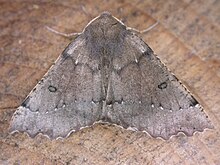Scalloped hazel
| Scalloped hazel | |
|---|---|
 | |
Scientific classification | |
| Kingdom: | Animalia |
| Phylum: | Arthropoda |
| Class: | Insecta |
| Order: | Lepidoptera |
| Family: | Geometridae |
| Genus: | Odontopera |
| Species: | O. bidentata |
Binomial name | |
Odontopera bidentata (Clerck, 1759) | |
Synonyms | |
| |
The scalloped hazel (Odontopera bidentata) is a moth of the family Geometridae.

Caterpillar


Contents
1 Distribution
2 Description
3 Biology
4 Larval food plants
5 Subspecies
6 References
7 External links
Distribution
It is a common species of northern and central Europe including the British Isles and Russia to the Urals. it is also widespread through Siberia and the Amur-Ussuri region to the Kuril Islands and Japan.
Description
The wingspan is 46–50 mm.The forewing ground colour is usually grey-brown. The same coloured midfield is bordered by blackish crossbars that are often partly white. At the wing edge below the apex are two characteristic, protruding teeth. The scientific name of the species is derived from the Latin language bi = "twice" and dentatus= "toothed".The outer dark cross line of the forewings continues on the hindwings. All wings have a ring-shaped dark discal spots. The thorax is hairy. This is a very variable species with the wing colour ranging from whitish through buff and brown to black, sometimes with variegation, but it is always easily identifiable by the white discal spot on each wing and the characteristic "ragged" margin of the wings.
The adults fly at night in May and June[1] and are attracted to light.
The caterpillar is green or brown and twig-like, and feeds on a variety of plants (see list below). The species overwinters as a pupa.
^ The flight season refers to the British Isles. This may vary in other parts of the range.
Biology
Habitats include deciduous and mixed woodland, bog forests and parklands.
Larval food plants
Alnus – grey alder
Arctium – burdock
Artemisia – mugwort
Betula – birch
Cirsium – creeping thistle
Crataegus – hawthorn
Fraxinus – European ash
Hedera – ivy
Larix – larch
Ligustrum privet
Malus – apple
Picea – Norway spruce
Pinus – Scots pine
Populus – poplar
Prunus – bird cherry
Quercus – oak
- Rhododendron
Ribes – currant
Salix – willow
Sorbus – Rowan
Tilia – lime
Trifolium – red clover
Vaccinium – bilberry
Subspecies
Odontopera bidentata bidentata (Clerck, 1759) (Europe)
Odontopera bidentata exsul Tschetverikov,1904 (eastern Asia)
Odontopera bidentata kurilana Bryk, 1942 (the Kuriles)
References
- Chinery, Michael Collins Guide to the Insects of Britain and Western Europe 1986 (Reprinted 1991)
- Skinner, Bernard Colour Identification Guide to Moths of the British Isles 1984
External links
| Wikimedia Commons has media related to Odontopera bidentata. |
- Scalloped hazel up UKmoths
- Fauna Europaea
- Lepiforum.de